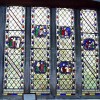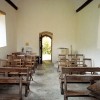Woodbury Hill and Charborough House
Celia Fiennes travelled home by way of Blandford and then headed southwards. She describes how “…we pass Woodbery (Woodbury) Hill eminent for a great Faire that is kept there of all things”. The fair dates from the times of Henry III and was once an important event that extended over several days. This is the Greenhill Fair of Thomas Hardy’s novels. Sir Frederick Treves in his Highways and Byways in Dorset tells us: “Since the time of Henry III, a fair has been held on this hill, commencing on September 18th, near about the festival of the Nativity of the Blessed Virgin Mary. This fair was at one time the most important in the South of England”. Treves was writing at the start of the 20th century, by which time the fair had declined and was reduced to a local event of little importance. In the heyday of the fair it had lasted five days and presented the lord of the manor with an income from tolls and fees totalling £100 a day.
Celia tells us “The road passed by Cherbery (Charborough), the foot of the hill; on the stop stands a pretty seate of Mr Earles my relation, the house is a new built house on the brow of a hill, whence you have large prospects of 20 mile round, you may see Shaftesbury 16 mile off”. Of Charboorough House she comments “…good gardens walled with plenty of fruit, good fish and decoy ponds”. Celia describes the fine entrance hall that “…leads you to a large parlour and drawing room and another parlour for smoakening, all well wanscoated and painted”. General Thomas Earle (or Erle) (1650-1720) fought in William III’s Irish campaigns and later in France and Spain. In times past the Earles held the manor for pouring water on the King’s hands on Easter or Christmas Day.
Another Visit to Dorset
In 1698 Celia Fiennes set off on another journey, which she describes as “My Great Journey to Newcastle and to Cornwall”. Along the way she comes again to Dorset entering the county by way of Chard and Leigh, where again she stays at a property owned by her relation, Mr Henly. It is not clear if this is the same Mr Henly of Colway, Lyme Regis, who she stayed with on her earlier visit to Dorset; the family owned both places at the time. Her next stop must have been a great disappointment for her – she called upon Mr Prideaux of Forde Abbey, which she says is “…a fine old house and well furnish’d but they permit none to see it…So I saw it not. Only drove by it to see my Cozens little girle at nurse”.
She then travelled to “…a little town called Maiden Newton and thence to Dorchester town 6 miles more, all a fine hard gravel way and much on the downs, this is good ground much for sheep: thence I went to Blandford 12 long miles through Piddletown and Milborne and Whitchurch there I staid with my relation Cos’n Collier, Husys and Fussells”. Celia pronounces it “good ground for sheep”. At the time sheep farming was a major activity in Dorset. A century later it was reported there were 800,000 sheep in the county of which 150,000 were sold annually and despatched out of the county.
What an adventurous woman Celia was! She travelled hundreds of miles, although her estimation of distance between places is not always accurate and her journey’s were made easier by the abundance of relations she had all over the country. Her comments about the pleasant prospects, trade and manufacturing, descriptions of buildings, and the sports and recreations of the communities she passed through provide a valuable social history of the time.
At the conclusion of her Journeys Celia urges both ladies and more so gentlemen to travel in their native land and suggests doing so would preserve them from the diseases of the vapours and laziness, and cure the “…evil itch of over valuing foreign parts”. She had especially strong words for those gentlemen who represent the people in Parliament and she was of the opinion too many of them were ignorant about what was happening outside of the place they represented. She thought they had a duty to familiarise themselves with what was happening in the rest of the country and should know of the “Genius of the Inhabitants, so as to promote and improve Manufacture and Trade and to encourage all projects tending thereto”. Celia encourages ladies to take more notice of their neighbours to see how they may help them, especially the poor. This, Celia suggests, would alleviate the boredom and the burden of time spent tediously when not at the card or dice table and, she goes on, the fashions and manners of foreign parts will be less attractive.
Finally she says “…with a hearty wish and recommendation to all, but especially my own sex…to study those things which tends to improve the mind and makes our lives pleasant and comfortable as well as profitable in all the stages and stations of our lives and render suffering and age supportable and death less formidable and a future state more happy”.



